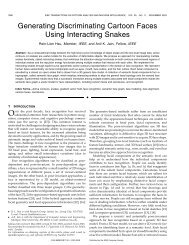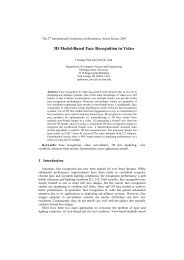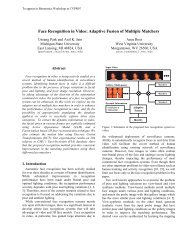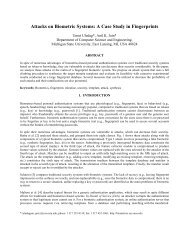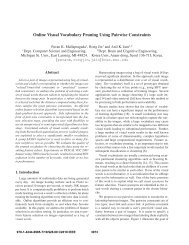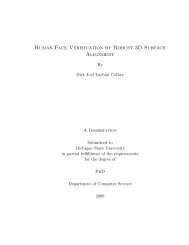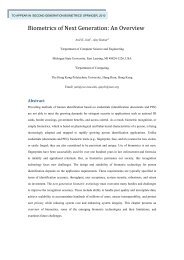Face Detection and Modeling for Recognition - Biometrics Research ...
Face Detection and Modeling for Recognition - Biometrics Research ...
Face Detection and Modeling for Recognition - Biometrics Research ...
You also want an ePaper? Increase the reach of your titles
YUMPU automatically turns print PDFs into web optimized ePapers that Google loves.
images with registered range data) captured in the frontal view; the other takes only<br />
color images as its facial measurements. Both modeling methods adapt facial features<br />
of a generic model to those extracted from an individual’s facial measurements in a<br />
global-to-local fashion. The first method aligns the model globally, uses the 2.5D<br />
active contours to refine feature boundaries, <strong>and</strong> propagates displacements of model<br />
vertices iteratively to smooth non-feature areas. The resulting face model is visually<br />
similar to the true face. The resulting 3D model has been shown to be quite useful <strong>for</strong><br />
recognizing non-frontal views based on an appearance-based recognition algorithm.<br />
The second modeling method aligns semantic facial components, e.g., eyes, mouth,<br />
nose, <strong>and</strong> the face outline, of the generic semantic face graph onto those in a color face<br />
image. The nodes of a semantic face graph, derived from a generic 3D face model,<br />
represent high-level facial components, <strong>and</strong> are connected by triangular meshes. The<br />
semantic face graph is first coarsely aligned to the locations of detected face <strong>and</strong> facial<br />
components, <strong>and</strong> then finely adapted to the face image using interacting snakes,<br />
each of which describes a semantic component.<br />
A successful interaction of these<br />
multiple snakes results in appropriate component weights based on distinctiveness<br />
<strong>and</strong> visibility of individual components. Aligned facial components are trans<strong>for</strong>med<br />
to a feature space spanned by Fourier descriptors <strong>for</strong> semantic face matching. The<br />
semantic face graph allows face matching based on selected facial components, <strong>and</strong><br />
updating of a 3D face model based on 2D images.<br />
The results of face matching<br />
demonstrate the classification <strong>and</strong> visualization (e.g., the generation of cartoon faces<br />
<strong>and</strong> facial caricatures) of human faces using the derived semantic face graphs.<br />
146



